by Zig Zag / Warrior Publications
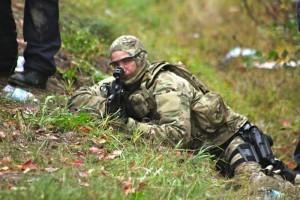
RCMP ERT member providing cover fire for Tactical Troop, Oct 17, 2013.
There has been a lot of speculation and misinformation concerning the deployment of RCMP officers during the assault on the anti-fracking blockade in Rexton, New Brunswick (in Mi’kmaq territory) on Oct 17, 2013. So much, in fact, that I have been inspired to provide this brief overview of the RCMP deployment, units, weaponry, and tactics.
Delta Farce
First, let’s deal with one of the more outlandish claims being asserted about the RCMP assault by conspiracy theorists: the alleged presence of US military personnel. It has even been suggested that these soldiers were members of the US Army Delta force, the most secretive and elite of all US special operations forces. This bit of misinformation appears to have resulted from the choice of camouflage fatigues used by the RCMP’s Emergency Response Team (ERT) that accompanied the regular RCMP officers.

Not Delta farce, but an RCMP K9 unit attempting to intimidate protesters, Oct 17, 2013.
In this photograph, a K9 unit officer attached to the ERT (it is normal practise for ERT units to have K9 units with them) can be seen wearing Multicam, developed by Crye Precision. This camouflage was recently adapted by the US Army for operations in Afghanistan and may become standard issue pending the results of a competition to find a new camo pattern.
Apparently, some people have seen this camo pattern used by the RCMP ERT in New Brunswick and wrongly assumed they were US soldiers. Multicam, in fact, is in use among many military and police forces (including the British military).
The photograph above in particular was circulating as “proof” of the presence of the US Army Delta force because of the triangle shape on the officer’s baseball cap. This, it was claimed, was the insignia of the Delta force. In reality, Delta does not wear insignia on its combat fatigues (it’s super secret!) and the insignia in fact is the nose piece of this cop’s protective eyeglasses. You can also see on his left shoulder the RCMP shoulder badge and a police tag across his chest.
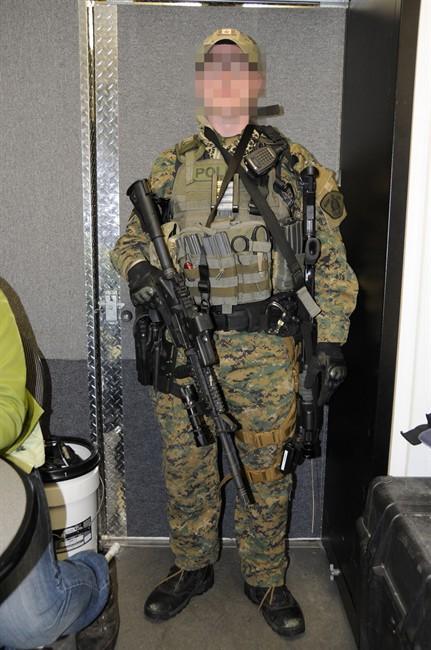
RCMP ERT member from Prince George, BC, 2009, wearing MARPAT, the camo pattern used by the US Marine Corps, armed with C8 carbine. Conspiracy theorists would probably assert the US Marine Corps had invaded Canada…
How many cops does it take…?
Some early reports of the RCMP deployment put their numbers as high as 700. After awhile, these numbers were reported as being between 100-200, which seems more realistic and in keeping with previous RCMP operations against Native blockades of a similar size (such as the 1990 operation against the Lil’wat blockade of Duffy Lake Road at Mount Currie, BC, during which over 60 people were arrested).
Sniper Sightings
Next, the snipers. This claim isn’t as outlandish as the one about Delta force, but if we’re gonna be Warriors we need to know our shit. All the photographs alleging to be of RCMP “snipers” are ERT members armed with M16 variant assault rifles. They have an effective range of approximately 500 metres. Real sniper rifles have effective ranges of between 800 to 2,000 metres, depending on their calibre. The RCMP ERT do have qualified snipers with long-range rifles, but I have not seen any of these in the photos published so far. The presence of a scope on a rifle does not make it a sniper rifle, as it is now standard for C7 rifles or C8 carbines (the Canadian military versions of the M16A2 and M4 carbine) to have optical sights.
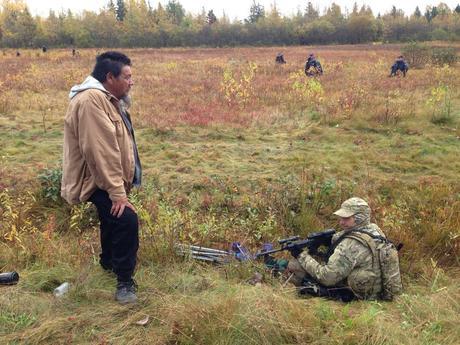
Cop blocker, Oct 17, 2013. This RCMP ERT member has an M16 variant, not a sniper rifle.
Emergency Response Team
Alright, since we’re on the subject, let’s talk about the RCMP Emergency Response Teams (ERT). They are the heavily armed units deployed for hostage takings, barricaded suspects, or any incident in which firearms are present, as well as VIP security, etc. They may number from 5-8 members in each ERT, each comprised of a leader, 1-2 snipers, and assaulters. Each RCMP district across the country has an ERT. During the 1995 siege at Ts’Peten (Gustafsen Lake, BC), the RCMP deployed nearly 450 cops, most of them ERT units from E Division (BC). At that time, they borrowed 8 Bison armoured personnel carriers from the Canadian Forces.
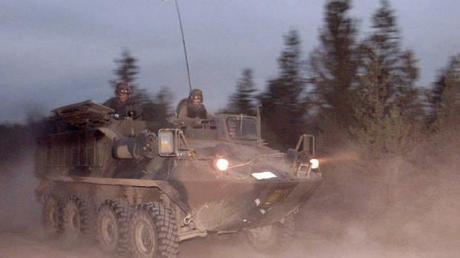
One of eight Bison APC’s used by RCMP ERT at Ts’Peten, 1995.
Why was the ERT deployed in New Brunswick? It is standard practise for the RCMP to use ERT during blockade situations, mostly for two reasons. First, they have some training in field-craft, camouflage, etc., and are used to provide covert surveillance of a blockade site. Secondly, they are used to provide lethal overwatch for regular patrol officers sent in to dismantle the blockade.
ERT units are also deployed with the RCMP’s Tactical Troop, which is their riot cops. In this situation, they provide lethal overwatch as well as shooters for various types of less-lethal weapons.
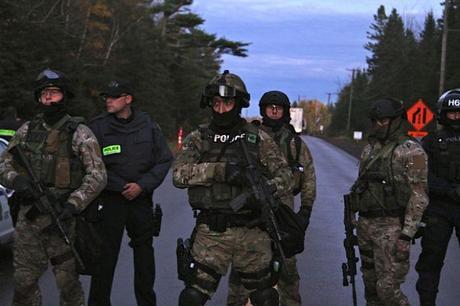
RCMP ERT members present on Oct 17, 2013. They are armed with C8 carbine variants of the M16A2 rifle as well as 9mm pistols.
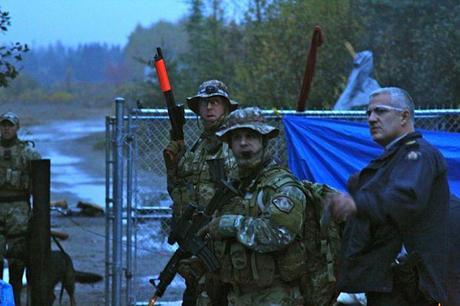
RCMP ERT members during early morning raid on camp, Oct 17, 2013. The shot gun with the orange stock fires less lethal rounds, such as bean bags, rubber pellets, or rubber bullets. RCMP shoulder badge is clearly visible on the cop in front.
As the situation at the anti-fracking blockade site began to intensify, the RCMP brought in more cops, including more ERT as well as a Tactical Armoured Vehicle (TAV). RCMP ERT across the country are now equipped with 18 of these vehicles, and each district in BC has one. They are manufactured by Navistar Defence Canada and cost $780,000 each. They can carry up to ten personnel. The TAV has gun ports on the side through which officers can fire their individual weapons as well as an armoured shield on the roof for a shooter.

RCMP Tactical Armoured Vehicle lurks in the background behind riot cops, Oct 17, 2013.
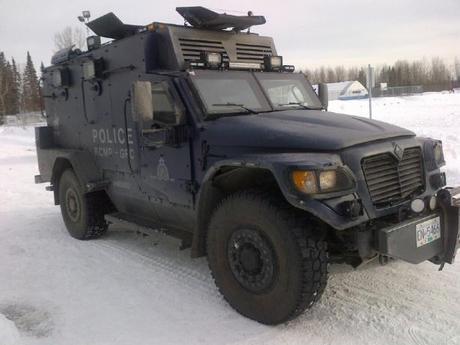
RCMP TAV in Prince George, BC, 2013.
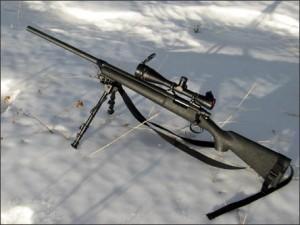
Remington 700, a 7.62mm sniper rifle, one of the types used by RCMP ERT snipers.
The standard weaponry of RCMP ERT members is a 9mm pistol and a rifle, most often a Heckler and Koch MP5 submachine gun (9mm) or a C8 carbine, the Canadian military version of the US M4 carbine (5.56mm, basically a shortened m16A2).
In rural areas they may carry a C7, the Canadian version of the US M16A2 assault rifle. ERT snipers use a 7.62mm rifle (.308), such as a Remington 700 or 300 Winchester Magnum.
RCMP Tactical Troop
The RCMP Tactical Troops are their crowd control units, or ‘riot squads’. They appear to be organized in platoon sizes of 30-40 personnel. Each district across the country has a Tactical Troop, which are comprised of regular patrol officers who receive extra training in crowd control, formations, etc, as well as protective gear (helmets, shields, gas masks, body armour, etc.).
RCMP Tactical Troops have seen action at the 2001 Summit of the Americas clashes in Quebec City, the Toronto G20, as well as the 2011 Canucks Riot in Vancouver, BC.
Initially, it would appear that the RCMP sent in a large number of officers on Oct 17, perhaps as many as 50-70, to dismantle the anti-fracking blockade. As noted, they were accompanied by the ERT which is a standard practise of many police forces when deploying crowd control units.
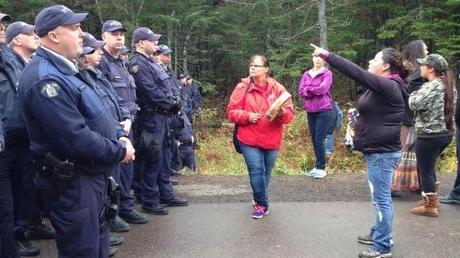
These RCMP members are in ‘soft tac’ mode. They have no helmets or shields.
These cops first deployed appear to be members of a Tactical Troop in ‘soft tac’ mode. That is, they are riot cops (crowd control) deployed in a low-level tactical mode with baseball caps and their regular patrol belt (including their 9mm pistols, tactical baton, and pepper spray). Some of these cops have Tasers as well.
Soft tac is used when a crowd control situation is deemed to be less threatening and the likelihood of projectiles being thrown, etc., is fairly low. It also helps minimize the more aggressive imagery of fully armoured riot cops. Depending on their threat analysis, police may send in soft tac cops but have hard tac forces on standby.
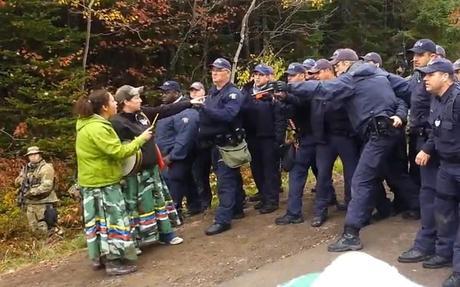
In this photo from Oct 17, you can see how bulky these cops appear as they are wearing protective armour.
Later in the day, after things heated up, more cops were brought in including what are clearly Tactical Troop members in ‘hard tac’ mode, with helmets and shields. Under their fire retardant cover-alls, these cops wear body armour to protect against projectiles (such as rocks) as well as baton strikes, etc. This gear can weigh up to 80 pounds or more, meaning these cops are heavy and slow.
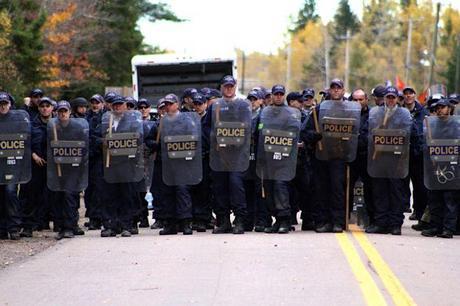
At some point, the ‘soft hats” went and got their shields and 3 foot long riot batons, perhaps even out of that cargo truck in the background.
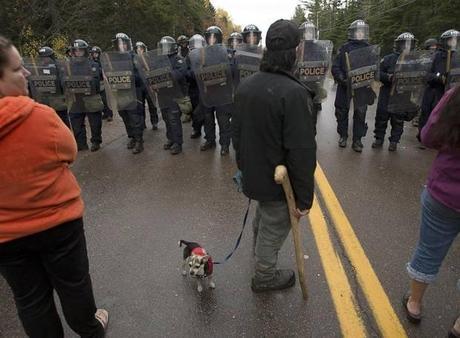
RCMP Tactical Troop in their ‘hard hat’ (hard tac) mode, with helmets, shields and 3 foot long riot batons. On their left sides are gas masks in OD green carrying cases.
Tactical troops have a wide variety of less-lethal weaponry at their disposal, including anti-riot weapon (ARWEN) rifles that fire rubber baton rounds, tear gas canisters, rubber pellets, as well as bean bag rounds. 12 guage shotguns are also widely used by riot cops to fire similar types of less-lethal rounds, most often rubber pellets and bean bags. Pepper spray is frequently used in skirmishes, and tear gas is used to disperse large crowds either through hand-thrown canisters or projectiles shot out of less-lethal weapons.
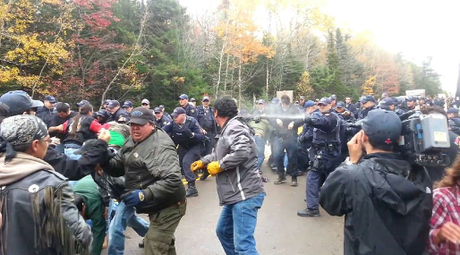
RCMP pepper spray crowd, Oct 17, 2013.
All these projectiles are capable of causing severe blunt trauma wounds if fired at close-range. Tyson Peters, a member of the Mi’kmaq Warrior Society, was shot in the leg with a less-lethal on Oct 17 and now risks amputation after delaying treatment for two days. Less-lethal rounds have in the past resulted in serious injuries such as brain damage, blinding, as well as death (which is why they are called less-lethal, not “less-than-lethal”).
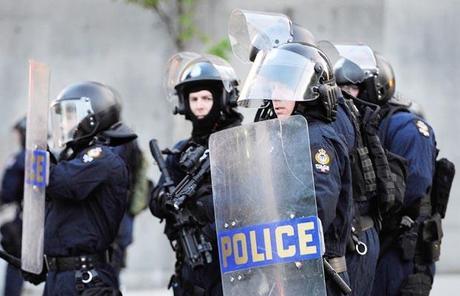
Vancouver police ‘Public Safety Unit’, showing less-lethal weaponry carried by shooters (Canucks Riot 2011).
I hope this article clears up some of the misinformation that is spreading through social media about the police deployment in New Brunswick on Oct 17, 2013. I have not touched on defensive measures people can use against such police assaults but will do so in a future article.

